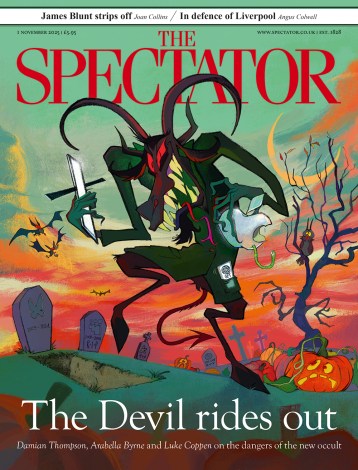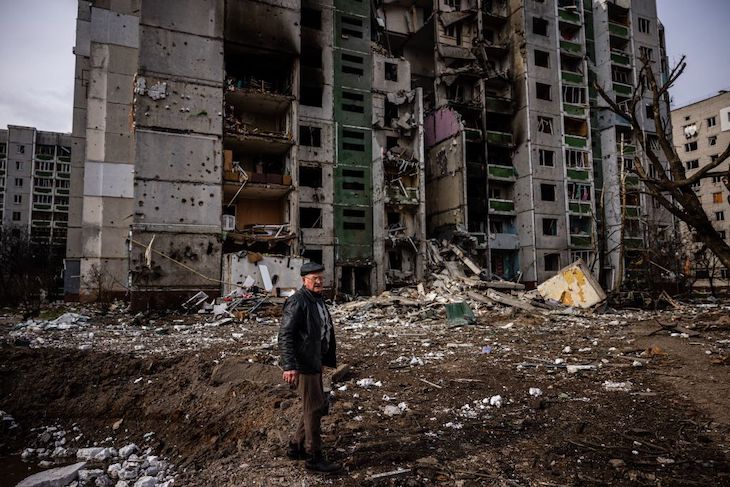First, the power went out in the bar. A few minutes later came the familiar low, concussive thud of an explosion nearby, the kind that makes the walls tremble and the glasses rattle on the shelves. Somewhere close, a few streets perhaps, a Russian drone had found its mark. Almost as quick as it came, the sound dissipates, leaving an ambivalent quietness in its wake. Inside, the waitress lights candles, which flicker as if battling to keep darkness at bay. From a phone sitting on the bar, she plays music, the sound, tinny and weak, fighting to drown out the silence. Outside, buses speed along the street, clamorous beacons of light patrolling in the gloom. Only a moment later, it’s as though the explosion had not happened.
Elsewhere in the city, life continues in spite of the dark and the drones
This is daily life in Chernihiv, a city just a few hours north of Kyiv and barely a handful of miles from the Russian border. It’s nine o’clock, and the evening already feels long, the hum of drones and wail of sirens too frequent and unexceptional to count.
Elsewhere in the city, life continues in spite of the dark and the drones. On an almost lightless street, so dark only the weak glow of distant stars is visible, Ihor’s mother is celebrating her birthday. It is her fourth since the war began, and this one comes in total darkness. Inside, Ihor stands before her, presenting her with flowers and a cake, lit only by the candles which flicker above it.
‘To the victory,’ she says, ‘of Ukraine over Russia’ before blowing out the candles, plunging the house once again into total darkness. Around her, her children, their partners, and a few friends whoop and cheer, and for a moment, the gloom feels somehow less absolute. Eventually, power returns, heralded by almost an imperceptible electronic beep from somewhere in the kitchen and the quiet whir of a refrigerator coming back to life. Anywhere else, these unassuming sounds of home would go largely unnoticed, yet in Ukraine, people have become acutely attuned to every hum or flicker that signals reprieve. Conversation soon drifts to the early days of the war, to shared stories of attacks and the fates of neighbours.
Chernihiv is among Ukraine’s oldest cities and one of its most beautiful. In the daylight, the scars of Russia’s invasion nearly five years ago are widely visible, standing out against the city’s landscaped gardens and ancient churches. On the outskirts of the city, where the surrounding Russian forces were halted, entire apartment blocks crumble. Today these buildings are little more than concrete skeletons and shells, constant reminders of how narrowly defeat was avoided. Approaching the centre of Chernihiv, warehouses and power plants stand battered, rusting, and overgrown as a result of more recent attacks.
When Russia’s winter campaign against the Ukrainian power grid began a few weeks ago, Chernihiv was the first city in the line of fire. By early October, strikes had left the city without power for up to nine hours at a time.
Every autumn in Ukraine since the war began has brought with it warnings of a harsh winter ahead and promises of blackouts; but Moscow’s tactics have evolved and this year, the threat feels particularly pressing. Where summer brought broad, sweeping barrages, this year’s winter campaign is patient, deliberate, insidious, focused on one target at a time. In the morning, drones circle above for hours between strikes, preventing workers from repairing freshly hit critical infrastructure and forcing much of the population underground, into basements, metro stations, and above-ground concrete shelters.
Unlike in Kyiv, where air raids tend to come overnight, fading away with the morning light, in Chernihiv the waves of attacks are ceaseless. In the middle of the afternoon, the city is loud. Drones are launched from across the nearby Russian border, reaching the region in minutes and the city not long after. Their presence is felt constantly, the distinctive whine of their moped engines rising and falling over the rooftops of the city, filling its streets. Almost as alarming as the sharp buzz of the drones is the intermittent response of Ukrainian air defence, the crackle of machine gun fire and the deeper sounds of larger guns firing only intermittently. Even in its calmer moments, Chernihiv feels more like a frontline city than one three hundred miles from the front.
As night falls again, it takes less than thirty minutes for Chernihiv’s pretty streets to become cold and ominous. Turn off any of the city’s main streets, lit by the occasional traffic light and the headlamps of passing cars, and the darkness closes in. Standing between imposing Soviet-era apartment blocks, there is no light, their vast facades melting seamlessly into the inky black sky. Strangers pass one another in courtyards, barely visible to each other as they hurry home to generators and car batteries used to power lights and phones. By six o’clock, a heavy darkness swallows the city whole, and the air feels pregnant with memory, with history, and the presence of war, invisible as the biting autumn wind.
As winter looms, temperatures are dropping, and this year promises a winter harsher than any since the war began. The long, dark nights, the constant threat and sound of drones, the blackouts, and the fickle emergency power schedule all work in concert to make survival a gruelling task.
Chernihiv has endured close calls in the past, and yet, as elsewhere in Ukraine, life persists. Here, civilians navigate the invisible contours of war with a careful, measured vigilance. For now, the light always returns, no matter how long its residents have been without it. But as the darkness and winter draw in, they bring with them the ever-present memory, and threat, of war.







Comments